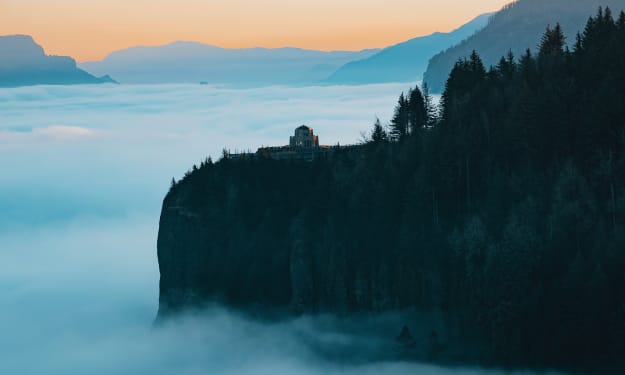
Qian Zhongshu once used a city wall as a metaphor for marriage, saying, "Marriage is a walled city, people outside the city want to get in, people in the city want to get out.
This is probably based on the reality of the formation of the city walls. In the eyes of the people in the city, the people outside the walls, is blocked. But in the eyes of those outside the city, those inside the walls, are trapped.
But what if one stands on the city walls? What about looking down to the left and right.
It was already dark when I wandered through the Bell Tower and came under the Yongning Gate. Entering the Moon City, I touched the ancient bricks and climbed up the stairs to the city walls. People were sparse, and those who climbed the walls at this time of the year seemed to be alone.
A cold wind, wrapped in some sort of suggestion, swept over the city. The banners hunted, like a hue and cry, more like a struggle. There was a sense of oppression of a great army approaching. But ancient Chang'an was calm, and the city lights were like daylight. At night, you can't see far away, the moat under the walls near the city, lights and shadows swaying, more like a small and exquisite garden.
Above the city walls, more spacious than I thought, can always drive two or three small cars side by side. After leaning over the battlements and looking outside the city, I had to turn around and walk about ten steps to look down into the city.
Inside and outside the city, there is not much difference, but it is a straight wall, you can not climb up and dare not jump down. Inside the wall and outside the wall, it's all about the city. Cars run through the city gate hole, coming and going as they please, and there is no obstruction. No enemy troops came to break through the gates, and no one in the city tried to escape the danger.
After the end of the Cold War era, the city walls no longer have meaning, standing here, is just an accidental remnant of history, a scenery for people to pay homage to it.
Since when did mankind think of building walls?
This must be a strategy to circle the sphere of influence, as animals use dung to mark the territory. And, of course, it must also be a security strategy to defend against enemy attacks. From the Chinese literature, there is a saying that "the Yellow Emperor built a city to create the five yi". The legendary Shennong and Huangdi already had the act of building a city in their time.
A village formed by a community began to build a wall of rammed earth to defend itself from wild animals and enemies, which must have been the prototype of a city wall. When the number of people and the scope of the community to a certain extent, it became a city, the wall became a city wall. The walls, besides being used for defense, also became a symbol of power and sphere of influence.
The archaeological community has found that there were indeed a large number of city cites in the Middle and Late Neolithic period. For example, in Sichuan, where I am from, there are the ruins of the ancient city of Xinjin Baodun and the ruins of Sanxingdui, both of which have the remains of earthen walls in existence.
Probably the oldest wall I have climbed directly is the ancient city wall of the Shang Dynasty in Zhengzhou. These early Shang Dynasty walls were rammed with earth, and remnants remain for seven kilometers. The best preserved section has a long ladder built around the wall for easy access, and the wall is a park. At dusk, the old people are singing the opera under the trees with their huqin, which is a bit like the old days.
Another section of the wall is filled with houses. When I was there, the houses on the wall had just been demolished, probably to be built as a park to protect and develop. When I stepped on the rubble and walked through the weeds, I didn't feel like I was walking on the walls. I just imagined how the people who lived on the wall should distinguish between the city and the city, and how to express the way out of the city and into the city.
Years later, walking on the ancient Ming Dynasty walls in the twilight, this fearful question rose again inexplicably. It's just that more than a decade has passed, and I wonder what happened to the earthen walls of Zhengzhou.
The walls, after all, represent a barrier of sorts, and there is a dilemma between the walls and the walls.
The rise of the tide of city building, the first is to declare some kind of power and majesty. For example, in the Zhou Dynasty, the city of the Son of Heaven and the city of the vassals, from the size and height are strictly different, not arbitrary increase or decrease. Another reason, naturally, is the frequent wars and conquests. During the Warring States period, when lords and vassals were at war, the struggle for cities and towns was the norm in diplomatic and political life. If you want to not so quickly become the king of the fallen state, naturally, the only way to build high walls.
At this time, the walls began to take on the meaning of partition. Some vassal states, in order to better defend themselves against their enemies, simply built walls on their border lands to separate all of their lands and nationals from each other, once and for all.
This thinking of building walls at the borders developed to the extreme and eventually led to the Great Wall, the marvel of military architecture in Chinese history. The Great Wall was an expansion of the wall mentality, connecting intermittent border walls to increase the length and width of the defense for peace of mind. But, deep down, the builders were actually helplessly afraid. It was also the inert rejection, closure and resistanceism that simply closed the doors of communication in order not to be extinguished. They wanted to establish undisturbed eternal bliss, or unbreakable dominion for all time.
A friend said that the local folk often say "break the wall thinking". The idea is that although the ancient city wall is a valuable cultural heritage, it invariably traps people's way of thinking and requires a breakthrough in both urban development and business operations. In the eyes of modern people, the wall extends out to mean not protection but siege.
To be sure, the modern meaning of the city has nothing to do with the walls anymore, and can even be said to have no boundaries. Like most cities in China, the city walls of my city were all demolished in the course of modern history. In recent years, the discovery by archaeologists of the ruins of a section of the remnants of the wall's foundation has been the news that has rocked the city. Such academic discoveries naturally add to the historical heritage of the city, but will never be taken as the city's boundaries.
After walking for half an hour against the cold wind, I chose a staircase to get down the wall. Under the wall, there are all kinds of fashionable bars and small stores, and it feels like coming back to the real world. The city under the wall is warm and boiling.
The meaning of "walled city" is probably different from that of Qian Zhongshu.






Comments
There are no comments for this story
Be the first to respond and start the conversation.